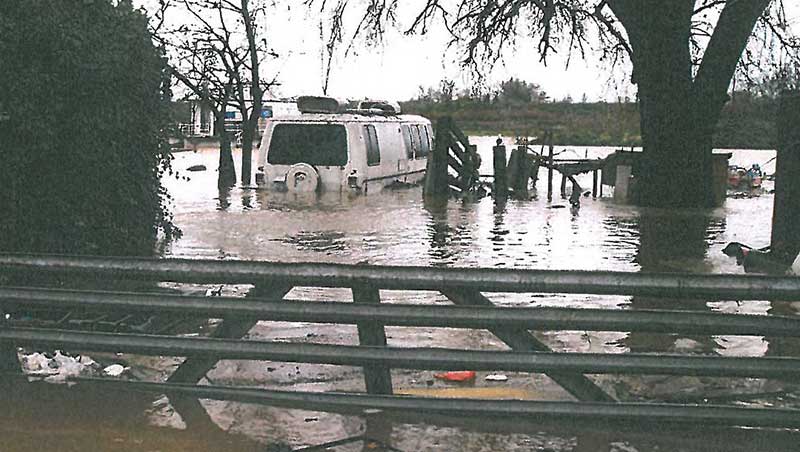December 24, 1955 flood on Plumas Street in Yuba City
The Northstate has a long history of flooding. This flooding has led to costly damage. While efforts are being made to reduce risk, the reality is there will always be a possibility of flooding. Awareness is the first step to making sure that you reduce your risk as much as possible.
Check out the flood risk information provided by the Department of Water Resources:
- The Central Valley is home to more than 1,600 miles of State-Federal levees. In many areas protected by this levee system, the risk of flooding is greater than the risk of fire.
- Since 1950, flood disasters have been declared in every California county at least ten times, with some counties having as many as 29 state and federal disaster declarations.
- Since 1983, Central Valley State-Federal project levees have been breached and overtopped more than 70 times.
- Local, State and Federal agencies are continuing to improve the State-Federal project levee system. But, there will always be some flood risk.
- Just one foot of flood water can cause more than $54,000 in damages to a $150,000 single-family home and its contents in the Central Valley; three feet of flooding could cause more than $93,000 in damages.
Central Valley Flood Risk
Why is flood risk so high in California? This video explores the history, risk and local/federal efforts to reduce flooding in California with one of the world's largest flood risk reduction systems. Produced by the Sacramento District and the California Department of Water Resources. This video is part of the Corps of Engineers Flood Plain Management Services Program (FPMS) which funds projects that educate the public about flood hazards where they live and work and actions they can take to reduce property damage and prevent loss of life. FPMS also provides technical assistance to local governments and interested groups.
Northstate Flood Facts
Reported economic losses in Shasta County attributed to large flood events were reported to be $3,790,000 in 1970 and $10,650,000 in 1974. Actual losses are believed to have been much greater. (Source: Shasta County and City of Anderson Multi-Jurisdictional Hazard Mitigation Plan)
There have been a total of 17 state and federally declared flood disasters in Shasta County between 1950 and 2009. The most recent of which included individual assistance for flooding in South Redding along Olney Creek in 2006. (Source: Shasta County and City of Anderson Multi-Jurisdictional Hazard Mitigation Plan)
Since 1950, the State of California has proclaimed Tehama County in nine states of emergency due to flooding. (Source: Tehama County Flood Mitigation Plan)
Trinity County has experienced major storm and flood events in 1955, 1964, 1972, 1974, and 1997. (Source: Trinity County Property Owners Flood Safety)
Flooding in a Drought: What’s the Risk? Plenty!

California is currently experiencing a prolonged period of drought. It’s easy to forget the winter rains that that we’ve come to know and love/dread so much. Flooding though, is possible even in drought years. Parched soil takes time to absorb rain. If rain comes suddenly, water won’t have time to absorb into the ground and will instead runoff where ever is the path of least resistance. If drainages are undersized or clogged with debris, significant amounts of water can end up where you don’t want it.
Roads, driveways, outbuildings and even your home can be inundated by floodwaters.
![]() Like a buildings rain gutters, drainages need to be kept free of debris. If the drainage is large, work with your neighbors to develop a plan. Make sure to get any needed permits before doing work. To learn about permits, go to SRWP Online Permitting Guide.
Like a buildings rain gutters, drainages need to be kept free of debris. If the drainage is large, work with your neighbors to develop a plan. Make sure to get any needed permits before doing work. To learn about permits, go to SRWP Online Permitting Guide.
The Positive Side of Flooding
It’s important to remember that flooding is natural. Healthy watersheds provide for the capture, storage and safe release of precipitation. These areas can provide additional benefits such as protecting critical habitat, enhancing natural or cultural resources and/or providing recreation opportunities.
Communities across the country are choosing property acquisition as a mitigation option for areas that repeatedly flood. These communities benefit from programs that provide funding and technical assistance to change hazards into community assets. These resources are available to your community as well!
![]() Learn how your community can participate in property acquisition projects by reviewing FEMA’s Property Acquisition Handbook for Local Communities.
Learn how your community can participate in property acquisition projects by reviewing FEMA’s Property Acquisition Handbook for Local Communities.
More Information
FloodSAFE California. California’s initiative to reduce flood risk.
FloodSmart. The official site of the National Flood Insurance Program.
National Public Service Campaign. Website on preparing for disasters.
Tehama County Flood Safety Brochure
Managing Flood Risk: A Guide for Successful Mitigation. Guide on how to engage community and build partnerships, develop competitive grant proposals, & seek funding from state and federal agencies to address flood risk issues.
Flooding on the Sacramento River. Video discussing historic flooding along the Sacramento River and why we need to adapt management efforts for the future.
Protect Your Property from Flooding. Publications from FEMA.
